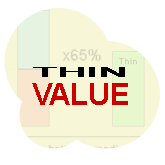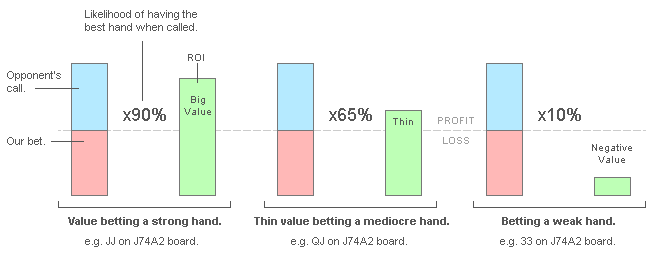Thin Value
Thin Value > Example

The term “thin value” is used quite a lot when discussing tricky decisions on the river in Texas Hold’em. The ability to get thin value from marginal hands is often the difference between good players and great players, so it’s worth taking the time to learn about it.
Hopefully you already know the basics of getting value from hands already, but if not, read about value betting first.
What is thin value?
Thin value is where you value bet marginal hands on the river and expect to make only a small profit from those value bets over the long run.
That’s the basics of it, but to fully understand thin value betting we’re going to need to compare "standard value bets" to "thin value bets". A slightly complicated diagram might help as well.
Thin value explained.
With a strong hand you always want to bet and raise to get as much value from the hand as possible. That’s common sense. So generally speaking, with a hand and a board like this:
Your Hand: J![]() J
J![]()
Board: J![]() 7
7![]() 4
4![]() A
A![]() 2
2![]()
...you are going to betting and raising all day. There is so much value in betting here it’s ridiculous.
Conversely, if the hand looked like this:
Your Hand: 3![]() 3
3![]()
Board: J![]() 7
7![]() 4
4![]() A
A![]() 2
2![]()
...you are going to be checking until the cows come home, because you don’t expect any worse hand to call. Hence, there is no value in betting here.
The art of getting thin value is when our hand is in the middle of these two extremes and it’s not quite as easy to tell whether there is value in betting our hand or not.
Thin value diagram.

This diagram highlights the difference in profit there is to be made between standard value bets, thin value bets and when there is no value in betting based on the percentage likelihood of having the best hand when called.
If we have the best hand greater than 50% of the time, we make a profit. If we have the best hand less than 50% of the time, we lose money because we’re risking more than we get back (a negative ROI if you will). The smaller the likelihood of having the best hand when called, the thinner the value.
Note: When making a value bet we actually want to get called because we expect to win money when we are called over the long run. If you don’t want to get called it’s not a value bet, it’s a bluff. See reasons for betting.
Thin value betting example.
I’ve put the thin value betting example on a separate page. This article is long enough as it is.
Benefits of thin value betting. Why bet for thin value?
So why exactly should you worry about thin value? Why not just check behind with marginal hands on the river? Well, there are two reasons:
- You win more money by making thin value bets.
- You become harder to play against if you make thin value bets.
- (and if you’re harder to play against, you make more money again).
1) Every time you have the opportunity to get value from your hands, no matter how marginal it is, you should take it. The extra few BBs here and there will add to your winrate, so why would you ignore it? If you can learn how to bet for thin value you will increase your winrate, it’s as simple as that.
2) If you bet for thin value, you will be balancing your range when you’re betting on the river. With a balanced range you make it more difficult for your opponents to play against you, which means they will make more mistakes. The more mistakes they make, the more money you will be winning from them.
As I’ve already mentioned, thin value betting often distinguishes the good players from the great players. If you want to improve your game and your winrate, you will want to get to grips with the art of thin value betting in poker.
How to make good thin value bets.
There are two steps to making good thin value bets:
- You need to put your opponent on a range of hands.
- You need to evaluate how many hands in that range that you beat or have you beat if you bet and get called.
1) Giving your opponent a range.
If you can’t work out a decent range for your opponent based on the way they have played up until that point in the hand, your value bet will just be a shot in the dark. If you can’t figure our a good range then you’re better off checking (or thinking harder).
Your opponent needs to have an elastic calling range for you to be able to make a thin value bet.
2) Evaluating the hands in that range that you beat and do not have beat if called.
If there are lots of hands in your opponents range that can call a bet and you have beat, then there is obviously value in betting. Conversely, if there are more hands that have you beat, there is no value in betting.
The smaller the difference is between the two (hands you beat and hands that have you beat), the thinner your value bet will be. The better you become at working out your opponents range, the easier you will find it to make thinner and thinner value bets.
It’s easy enough to know how to make good thin value bets, but actually doing it is another thing. But as with all tough decisions in poker, it will get easier the more you practice.
Thin value betting evaluation.
Thin value betting is tricky but it makes you money, so don’t ignore it.
The key to value betting is being able to put your opponent on a range of hands. If you can do that, thin value bets will get a lot easier. If you can’t put your opponent on a range, you need to practice more or pay more attention to the way the hands play out as you go along. This is definitely a skill you should continually be trying to improve though anyway.
The sooner you get out of the habit of “playing it safe and just checking behind” with your marginal hands, the sooner you will open up the opportunity to add to your winrate and make more money from your sessions through thin value betting.
Try "putting players on hands" for an in depth look at assigning hand ranges to your opponents. Also, range merging is a prime example of getting thin value in certain situations.
Go back to the awesome Texas Hold'em Strategy.
Comments

